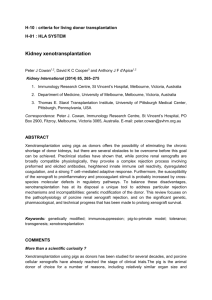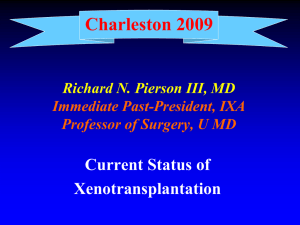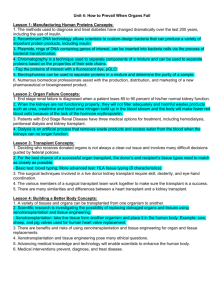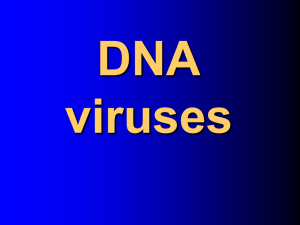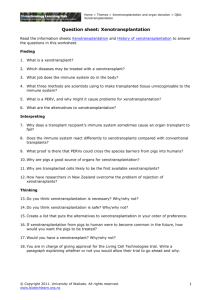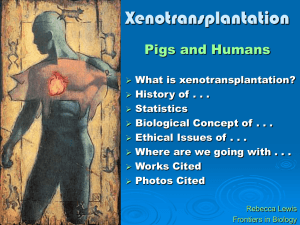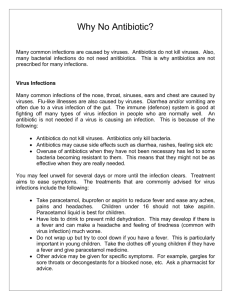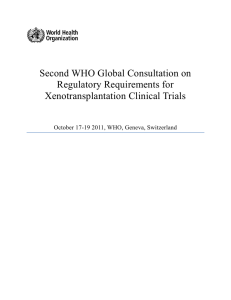Xenozoonoses: The Risk of Infection after Xenotransplantation.
advertisement
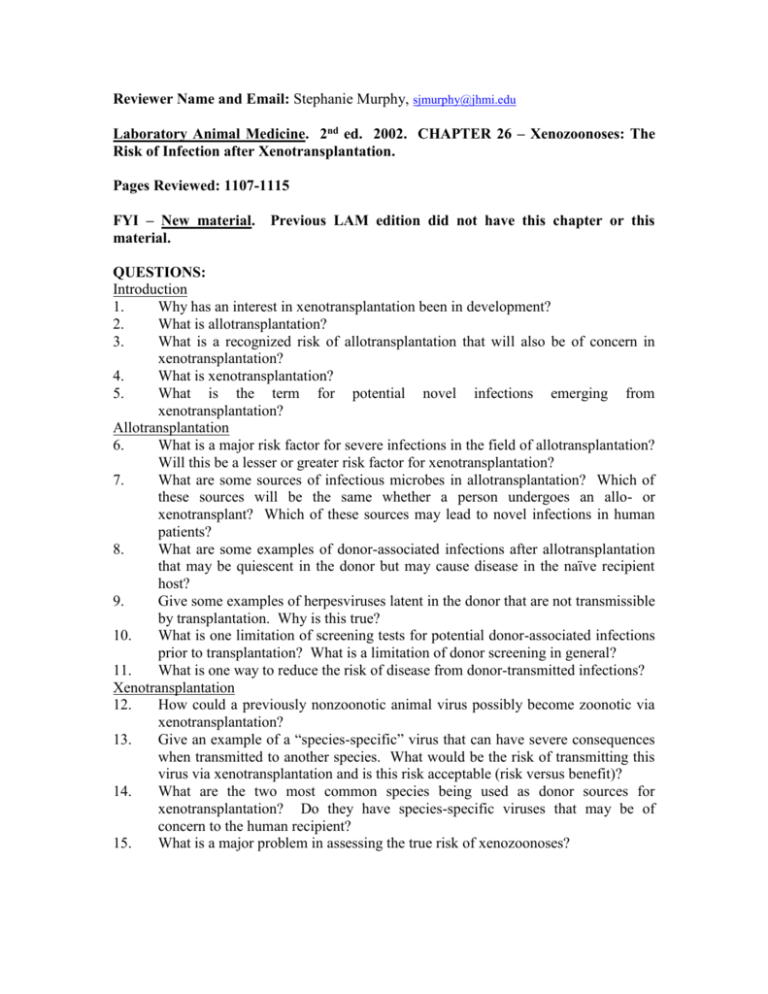
Reviewer Name and Email: Stephanie Murphy, sjmurphy@jhmi.edu Laboratory Animal Medicine. 2nd ed. 2002. CHAPTER 26 – Xenozoonoses: The Risk of Infection after Xenotransplantation. Pages Reviewed: 1107-1115 FYI – New material. Previous LAM edition did not have this chapter or this material. QUESTIONS: Introduction 1. Why has an interest in xenotransplantation been in development? 2. What is allotransplantation? 3. What is a recognized risk of allotransplantation that will also be of concern in xenotransplantation? 4. What is xenotransplantation? 5. What is the term for potential novel infections emerging from xenotransplantation? Allotransplantation 6. What is a major risk factor for severe infections in the field of allotransplantation? Will this be a lesser or greater risk factor for xenotransplantation? 7. What are some sources of infectious microbes in allotransplantation? Which of these sources will be the same whether a person undergoes an allo- or xenotransplant? Which of these sources may lead to novel infections in human patients? 8. What are some examples of donor-associated infections after allotransplantation that may be quiescent in the donor but may cause disease in the naïve recipient host? 9. Give some examples of herpesviruses latent in the donor that are not transmissible by transplantation. Why is this true? 10. What is one limitation of screening tests for potential donor-associated infections prior to transplantation? What is a limitation of donor screening in general? 11. What is one way to reduce the risk of disease from donor-transmitted infections? Xenotransplantation 12. How could a previously nonzoonotic animal virus possibly become zoonotic via xenotransplantation? 13. Give an example of a “species-specific” virus that can have severe consequences when transmitted to another species. What would be the risk of transmitting this virus via xenotransplantation and is this risk acceptable (risk versus benefit)? 14. What are the two most common species being used as donor sources for xenotransplantation? Do they have species-specific viruses that may be of concern to the human recipient? 15. What is a major problem in assessing the true risk of xenozoonoses? 16. 17. 18. 19. 20. 21. 22. 23. 24. 25. 26. 27. 28. 29. 30. 31. Besides herpesviruses, what is another type of virus that is often species-restricted but can sometimes have severe consequences when cross-species transmission occurs? Give an example. What types of retroviruses may be transmissible with xenotransplantation? Give an example for each type of retrovirus. What is the difference between exogenous versus endogenous retroviruses and why would this distinction be important for xenotransplantation? Give some examples of endogenous animal retroviruses that may be of concern in xenotransplantation. What are some other virus classes that have been transmitted after allotransplantation and may likewise cause disease after xenotransplantation? What is the etiologic agent for a recently discovered zoonotic disease infecting pigs and humans in Australia? Give some examples of nonviral agents that may cause xenogeneic infections if present in tissues being transplanted. What is one way that xenozoonoses could be substantially diminished in source animals? Define a gnotobiotic animal. What are some issues in raising pigs under gnotobiotic conditions? What are some alternatives to gnotobiotic animals? What are some logistic difficulties in creating and maintaining specific pathogenfree (SPF) nonhuman primate colonies? When developing protocols for screening source animals for xenotransplantation, into what four recommended categories should prospective microbial agents be placed? What is one problem in using serologic surveys to monitor etiological agents in source animals? How can one minimize this problem? What are some potential benefits of xenotransplantation? What are some of the guidelines recommended by the U.S. Public Health Service with respect to xenotransplantation? What U.S. Department of Health and Human Services committee has been formed to consider the complexities of xenotransplantation and to help with ongoing review of these procedures? ANSWERS: Introduction 1. Because of the great scarcity of human organ and tissue donors 2. Transplantation of organs, tissues, or cells between genetically dissimilar individuals of the same species 3. Risk of transmission of infections from donor organs, tissues, or cells to the recipient 4. Transplantation of organs, tissues, or cells between species. For example, baboon bone marrow transplanted into a human patient 5. Xenozoonoses Allotransplantation 6. The use of nonspecific immunosuppression to prevent rejection of the new organ or tissue. This risk factor will still be present, perhaps to an even greater degree when attempting xenotransplantation. 7. Recipient’s endogenous flora, the environment, or organisms harbored within the donated organ, tissues, or cells. The environment and the recipient’s endogenous flora will be the same for either type of transplantation. The graft itself may lead to novel infections in human recipients. 8. Hepatitis B virus, hepatitis C virus, human immunodeficiency virus, retroviruses, some herpesviruses (i.e. human cytomegalovirus, Epstein-Barr virus), some parasites (i.e. Toxoplasma gondii) 9. Herpes simplex and varicella zoster viruses are latent in sensory ganglia and as such are not usually present in blood or in the transplanted graft. They represent a very low risk of donor transmission based upon microbial tropism and individual properties of the microbe. 10. If donor is infected and has not had time to mount a detectable antibody response prior to donation or death. Except in the case of living related donation, donor screening is limited by substantial time constraints. 11. Prophylaxis and surveillance of recipients who are at risk can help with decreasing disease from donor-transmitted infections Xenotransplantation 12. During xenotransplantation, animal viruses similar to analogous human viruses come into communication with human cells to which they normally would not have access. Under these circumstances, such animal viruses might be capable of infecting humans. Also, some animal microbes that would not be pathogenic in a healthy person could cause disease after xenotransplantation due to immunosuppression of the recipient patient. Another concern is the potential for a crossover of genetic material between an animal and a human virus leading to a more virulent recombinant organism. It is also possible that some human viruses may cause disease in the animal graft. 13. Cercopithecine herpesvirus 1 (B virus) is generally innocuous in the host species (macaques) but can cause fatal disease after inadvertent infection of a human. Because this virus is latent in nerve endings and not in blood or organs, it is likely to have a low risk of transmission via xenotransplantation. However, disease severity makes any risk unacceptable. 14. Baboon and pigs. These species have alphaherpesviruses but it is unclear if simian agent 8 in baboons and pseudorabies in pigs can be transmitted to human recipients. There has been some anecdotal data suggesting transmission of pseudorabies between pigs and humans but the transmission mechanism is unclear. Cytomegalovirus (CMV) transmission between disparate species has also been suggested. 15. The lack of available and easy-to-perform techniques to differentiate human from animal viruses (i.e. cross reactivity of antigens from human Epstein-Barr virus and Herpesvirus papio). 16. Retroviruses. Simian immunodeficiency virus (SIV) is benign in its natural host, the African Green monkey, but progresses to an AIDS-like disease in macaques. 17. 18. 19. 20. 21. 22. 23. 24. 25. 26. 27. Probable transmission of SIV to two humans who were occupationally exposed has been documented as well with no clinical consequences. Lentivirus – SIV; oncogenic retrovirus – simian T-lymphotropic virus (STLV); foamy virus – nonhuman primate spumavirus Exogenous retroviruses behave like conventional, transmissible viruses. Endogenous retroviruses are integrated into the host genome (provirus) and depend upon their chromosomally integrated state for transmission. Endogenous retroviruses, unlike exogenous retroviruses, cannot be removed from sourceanimal populations by current rearing methods. All strains of pigs studied carry porcine endogenous retroviruses (PoERVs) within their genome. Likewise, baboon endogenous retrovirus (BaEV) is found in the baboon genome. Both PoERV and BaEV have been shown to be capable of infecting human cell lines in vitro. Adenoviruses, hepatitis causing viruses (i.e. Hepatitis B, C, and E viruses), reoviruses, circoviruses, paramyxoviruses Menangle virus Toxoplasma gondii cysts, Entamoeba histolytica, some schistosoma species, Hepatocystis kochi, Babesia species. Bacterial (i.e. Mycobacterium species) and fungal diseases require consideration as well. Raise source animals under strict germfree conditions A gnotobiotic animal, or gnotobiote, has been born germ free and then infected with know microorganisms. The microflora and microfauna of these specially reared animals are therefore known in great detail. Gnoto is a Greek word for known, and biota is lifeforms (i.e. microorganisms). Pigs can be raised under gnotobiotic conditions but have problems after several months of age due to size and waste production. Gnotobiotic environments preclude normal colonizations of the GI tract with normal microbial agents that aid food digestion. This is why gnotobiotic pigs are less robust and may not be ideal organ sources. Specific pathogen-free (SPF) animals. SPF animals are raised under controlled environments with which specific pathogens have been eliminated and the introduction of outside pathogens is prevented. Long time until sexual maturity; variable gestational period; single offspring per pregnancy; and dependent state during infancy. Vigilance must be strictly maintained against accidental introduction of microbes to established colonies from human caretakers or outside animals. Concern would still remain for possible xenozoonoses that were not initially screened out of a SPF population. Categories are defined with the most up-to-date information available but with the recognition that in the future, some infectious agents may be moved into different classes. (1) Absolute contraindications – microbial agents that are known to be zoonotic and dangerous to humans, even if they are not anticipated to be found in source animals (2) Relative contraindications – microbes hypothesized to be xenozoonotic but are unproven or with uncertain consequences (3) Treatable microbes – microbes that can be identified and eradicated prior to xenotransplantation 28. 29. 30. 31. (4) Unavoidable microbes – microbes that exist but are as yet unrecognized and thus of indeterminate risk. Serologic surveys have the potential to miss an immunologic response to a recently encountered agent. To minimize problems, select animals that tested negative initially should be quarantined and retested over time. (1) It is possible that xenotransplantation may decrease the risk of some infections after transplantation due to natural resistance of donor/source animal to specific infections (i.e. hepatitis B virus, HIV-1). (2) Xenotransplantation may avoid many donor-transmitted infections by permitting source animals to be reared in controlled, SPF environments and surveyed against acute infections. Public Health Service guideline on infectious disease issues in xenotransplantation <http://www.fda.gov/cber/gdlns/xenophs0101.htm> (1) Any recipient of xenogeneic tissue should undergo counseling about the potential risks and surveillance for infections after xenotransplantation (2) Serial samples from the recipient and transplanted tissues should be collected for cultures and/or assays to look for agents that were known or suspected to be in the source animal (3) Source animals should be reared in controlled, SPF environments and surveyed against acute infections. Secretary’s Advisory Committee on Xenotransplantation
